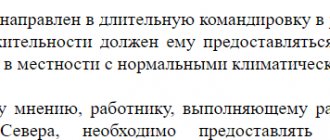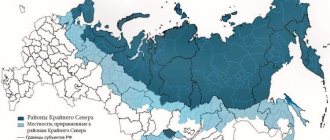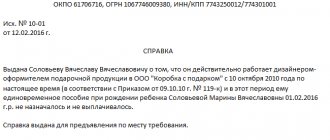The essence of the allowance for work in the North
Citizens carrying out labor activities in the territories of the Far North of the Russian Federation (KS) and equivalent to them, in cases established by law, receive a salary:
- increased by a certain percentage in the form of a surcharge;
- multiplied by the regional coefficient (Article 315 of the Labor Code of the Russian Federation).
The bonus and coefficient are applied when calculating wages based on the fact that the person actually works in the North: the location of his employer (company head office) does not matter.
The territories of Russia related to the Far North and equated to it are determined mainly by Resolution of the USSR Council of Ministers dated January 3, 1983 No. 12. You will find the full list here.
ATTENTION! From 2022, the list of northern regions will be changed. See this post for details.
The amount of the “northern” premium depends on:
- length of work experience in the North;
- the length of time a person has lived in the North;
- employee age;
- places where work is performed - at the compressor station itself or in regions equivalent to it. It also matters in which specific northern regions of the Russian Federation labor activity is carried out.
Let's study what the value of the premium in question could be.
How to calculate the payment yourself?
Each person, if he has a desire, can check the fairness of the calculation of his salary personally .
The regional coefficient is influenced by the climatic factor and the employer’s field of activity; for example, the coefficient in the oil and gas industry will be much higher than in the non-manufacturing sector.
The regional coefficient must be accrued on any actual employee earnings , including various labor bonuses, compensation, sick leave and pensions.
The coefficient will never be applied to travel, vacation payments and one-time bonuses.
At the same time , moving to another region is also grounds for canceling the northern coefficient .
Calculating the total amount is quite simple, just multiply the salary by the regional coefficient , taxes will be deducted from the amount in which the regional coefficient is already taken into account.
For example, a person’s salary in Murmansk is 20,000, and the regional coefficient is 1.5. Thus, 20,000 * 1.5 = 30,000.
In addition, the regional and northern coefficients must be calculated separately, and additional charges to wages will give both coefficients .
An example of how to calculate: an employee’s salary in the Komi Republic is 30,000, the regional coefficient in this area is 1.25, and the maximum size of the northern bonus is 50%. In this case, with sufficient experience, the amount of the bonus will be 15,000, and in the end the employee will receive 45,000 .
But that’s not all, because this amount will increase thanks to the regional coefficient: 45,000 * 1.25 = 56,250 rubles before taxes.
What is the size of the allowance for work in the Far North?
In the regions of the Constitutional Court, located mainly in the Far Eastern part of the Russian Federation (their list is determined by subparagraph “a” of paragraph 16 of the appendix to the order of the Ministry of Labor of the RSFSR dated November 22, 1990 No. 2), the northern allowance is:
- 10% of salary for the 7th month of work in the region;
- 20% on the 13th month of employment;
- 30, 40, 50 and so on up to 100% (this is the maximum amount of the bonus, mainly paid in Chukotka, the Koryak Autonomous Okrug and other peninsular and island territories of the Russian Far East with the most severe climatic conditions) every subsequent six months of work.
In other regions of the Far North of the Russian Federation, the allowance is (subparagraph “b”, paragraph 16 of the appendix to order No. 2):
- 10% for the 7th month of work;
- 20% for the 13th month of work;
- 30, 40, 50 and 60% every subsequent 6 months;
- upon acquiring the right to a 60% bonus, after another year of work the figure will be 70%, after two years it will reach the maximum value, 80%.
In territories equated to the KS, the allowance is (subparagraph “c”, paragraph 16 of the appendix to order No. 2):
- 10% for the 13th month of work;
- 20% on the 25th month of work;
- 30, 40, 50% (limit value) after each subsequent year of work.
If the employee’s age is under 30 years, then provided that he has lived in the Far North for at least a year, the increase in his salary will be:
- 20% for the 7th month of work;
- 40% for the 13th month;
- 60% for the 25th month;
- 80 or 100% (the limit value, respectively, for regions not related to the Far East and those located there) every subsequent year.
If you have access to ConsultantPlus, check whether you are applying regional allowances correctly. If you don't have access, get a free trial of online legal access.
Odds table by region
To find out where the highest rate is paid, you need to refer to the law on northern allowances. As can be seen from the table, in Yakutia and Yuzhno-Sakhalinsk it is at the maximum level, while Murmansk and Surgut have average values. Areas that belong to group 4 - normal climatic conditions with some peculiarities - have the lowest coefficient. This includes most of Karelia, Khabarovsk, Arkhangelsk, Primorsky Krai, and Ulan-Ude.
Video on the topic:
Calculation of the northern surcharge: nuances
The northern allowance is accrued on the entire amount of the citizen’s actual earnings (which may consist, for example, of salary and bonuses), excluding the amounts by which earnings increase due to the application of the regional coefficient.
Supplements are not awarded:
- for vacation and other payments, the amount of which is determined on the basis of average earnings, since it is formed taking into account allowances (clause 2 of the regulation, approved by Decree of the Government of the Russian Federation of December 24, 2007 No. 922);
- lump sum payment based on length of service;
- remuneration based on the results of work for the year;
- financial assistance paid by the employer (letter of the Ministry of Labor of Russia dated July 22, 1999 No. 716-7);
- one-time incentive payments that are not systemic in nature.
If an employee receives bonuses provided for in an employment contract, and they are paid based on the results of work for a certain period, for example, a quarter or a year, then the amounts of these bonuses for the purpose of calculating bonuses are distributed over the months that are included in the reporting period, with the bonuses being proportionally related to the hours worked employee in each of the relevant months.
The northern allowance should be calculated for compensation for downtime that arose for reasons beyond the control of the employer or employee (appeal ruling of the Krasnoyarsk Regional Court dated 08/06/2014 in case No. 33-7508/2014, clause 1 of the appendix to the resolution of the Ministry of Labor of the Russian Federation dated 09/11/1995 No. 49).
Employees who work remotely and live in northern areas are entitled to an appropriate bonus regardless of the geographic location of the employer. A similar rule applies to homeworkers (letter of the Ministry of Finance dated November 13, 2010 No. 03-03-06/1/716). But if employees of northern companies actually work in a place where the bonus is not established, they do not need to be awarded a northern bonus. For example, if the company is located in Yakutia, and an employee works from home in Sochi, he will not receive a bonus.
Basic Concepts
Every resident of the Far North of the country knows what northern allowances are. However, not everyone knows what the accrual percentage depends on and how they differ from the regional coefficient. The amount of compensation is affected by your place of residence, namely in which city you live. Thus, for residents of more severe areas, the surcharge increases after every 6 months by 10% and reaches 100%.
Employees may also be paid bonuses, which depend on the company's policy.
The regional coefficient represents a material additional payment only to persons who officially work in difficult climatic conditions.
Northern allowances and minimum wage
Art. 133 of the Labor Code of the Russian Federation determines that an employee’s monthly salary (1 rate) should not be lower than the minimum wage or the regional subsistence level, if such a condition is established in a constituent entity of the Russian Federation. The question arises: how to calculate an employee’s salary before comparing it with the minimum wage? If we are talking about regions of the Far North and equivalent regions, should we include bonuses in the salary amount or compare only the salary with the minimum wage?
At first, the Supreme Court believed that the payment of an employee who works in a “northern” company should not be lower than the minimum wage. And only then a regional coefficient and an allowance for work experience in the northern regions are added to it (clause 1 of the Review of the practice of consideration by courts of cases related to the implementation of labor activities by citizens in the regions of the Far North and equivalent areas, approved by the Presidium of the Armed Forces of the Russian Federation on February 26. 14).
However, in 2016, the position of the Supreme Court changed: setting a salary (tariff rate) in an amount less than the minimum does not violate labor legislation, provided that the total salary, including all its elements (allowances, coefficients, etc.), will not be less Minimum wage (determination of the Supreme Court of the Russian Federation dated September 19, 2016 No. 51-KG16-10). Let us note that this verdict contradicts the provisions of Art. 315, 316 of the Labor Code of the Russian Federation and Art. 11 of the Law “On State Guarantees and Compensations for Persons Working and Living in the Far North” dated February 19, 1993 No. 4520-I, which states that a percentage bonus is paid in addition to wages.
Thus, the current position of the Supreme Court leads to a deterioration in the rights of workers in the Far North and similar territories. However, the issue has not yet been settled - trade unions insist on excluding “northern” additional payments from the minimum wage.
You will find the minimum wage in the Russian Federation in this article.
Features of northern payments for different categories of workers
The amount of percentage compensation depends not only on the territory of residence, but also on the type of activity. For example, an employee who constantly moves from one place to another will receive an interest rate based on where he lives rather than the location of the company's headquarters.
For seasonal workers and those who work remotely, compensation is calculated individually. If an employee works remotely in a harsh climate and lives there, he is given a bonus on a general basis.
Recalculation of northern allowances when moving between regions
If an employee who has earned an allowance in the Far North moves to a region equated to a KS, then his salary will be subject to a bonus in the amount determined as the product of 10% and the number of years of work in the KS (subparagraph “a” of clause 3 of the clarifications of the Ministry of Labor of the Russian Federation , approved by resolution of the Ministry of Labor dated May 16, 1994 No. 37).
If an employee who has earned a bonus in a region equated to the Far North moves to the KS, then:
- the corresponding bonus is maintained and at the same time increased by a percentage proportional to the number of months of work in the region equated to the KS, taking into account the percentage by which the bonus should have increased during the year if the person had remained at the same place of work;
- the retained and increased allowance is subsequently increased in the manner prescribed by the provisions of Art. 16 of the appendix to order No. 2 (subparagraph “b”, paragraph 3 of clarification No. 37).
If an employee who earned a bonus first in the Far North region, and then in an equivalent region, moves again to the KS, then at the new place of work he will receive a bonus calculated as a result of summing up the bonuses that he had previously earned (sub. “ c" clause 3 of explanation No. 37).
If a person has earned a bonus in the regions specified in subparagraph. “d” clause 3 of explanation No. 37, and moved to the KS or to a region equivalent to it, then the corresponding allowance is retained and then increased in accordance with Art. 16 appendices to order No. 2:
- after 6 months - in the Far North;
- a year later - in a region equivalent to the CS.
If a person, at the time of moving to the Far North or a region equivalent to it, earned a bonus of 30%, then the time of his work after calculating the 1st or 2nd bonus is determined based on the ratio of 1 year of work in the south of the Far East, Buryatia , Khakassia, Irkutsk and Chita regions, as well as the Krasnoyarsk Territory to 3 months of work at the compressor station and 6 months in regions equivalent to it.
If a person earned an allowance at the CS or in a region equivalent to it, moved to the south of the above regions, worked there and then returned to the Far North or an equivalent region, he retains the originally earned allowance.
ConsultantPlus experts explained step by step how the “northern” experience, which gives the right to a percentage increase, is calculated. Sign up for trial demo access to the system and go to the HR Guide for free.
Results
Citizens who work in the North and have accumulated sufficient experience in the corresponding regions receive significant salary increases - in some constituent entities of the Russian Federation up to 100% of its value. The size of bonuses is also affected by the employee’s age - young people under the age of 30 have certain preferences in their calculation. Supplements are calculated for the entire salary (salary, bonuses) in the same way as regional coefficients (both compensations are calculated independently of each other).
Regional coefficients in the Labor Code
The Labor Code of the Russian Federation defines the regional coefficient as a mechanism for equalizing workers' incomes through an increasing financial indicator that indexes payments in regions with special climatic conditions and equivalent ones.
This method of government support for working citizens operates at the government and local level.
The Labor Code of the Russian Federation and other legislative acts prescribe this norm in the following provisions:
- Art. 316 of the Labor Code says that regional indexing coefficients are set directly by the Government of the Russian Federation, which does not exclude the possibility of additional “additions” from local budgets;
- Art. 146, art. 148 Labor Codes decipher in detail the concept of RK as a state-guaranteed supplement to various types of payments for working citizens;
- the territories in which the fixed RK will be relevant are given in Resolution of the Ministry of Labor dated September 11, 1995 No. 49;
- Art. 10 of Federal Law N 4520-1 of February 19, 1993 covers in detail the “northern” allowances.
Question: Is the regional coefficient applied to the wages of employees of separate divisions in Novosibirsk and Khabarovsk and are they provided with additional vacation days if the organization is located in Moscow?
Common Questions
How is length of service determined for calculating northern bonuses?
The length of service required to determine the amount of the bonus is calculated in calendar days. The length of service includes all the time spent working in areas with special climate conditions, including periods when the employee did not work, but retained his place of work (vacations, sick leave, etc.). Also in accordance with instructions No. 2 (clause 30) and No. 3 (clause 23), approved. by order of the Ministry of Labor of the Russian Federation dated November 22, 1990, the length of service for receiving the bonus includes:
- time for advanced training, professional retraining (up to 6 months), even if this occurs outside a zone with a special climate;
- periods of being at military training camps, including outside areas for work in which an allowance is due;
- time of forced absenteeism, if the dismissal is considered illegal and the employee is subsequently reinstated.
If a person goes on a shift to the North, then the length of service includes the time spent traveling there and back (Part 6 of Article 302 of the Labor Code of the Russian Federation).
The following are not included in the length of service when calculating northern allowances:
- Acting as an individual entrepreneur and working under civil contracts;
- serving in territories with a special climate correctional labor and other types of punishments that involve involvement in labor (clause 32 of instructions No. 2, clause 27 of instructions No. 3).
If the length of service is interrupted for legal reasons, the calendar days that make up the break are added to the length of service (clause 1 of the Resolution of the Council of Ministers - Government of the Russian Federation dated October 7, 1993 No. 1012).
The length of service, which entitles individuals working in the Far North to receive a percentage increase in monthly wages, is summed up regardless of the duration of the break in work and the motives for terminating the employment relationship.
According to clause 1 of the Decree of the Government of the Russian Federation dated October 7, 1993 No. 1012 “On the procedure for establishing ...”, it is established that the length of service that gives the right to receive percentage bonuses to the monthly salary for persons working in the Far North is summed up regardless of the duration of the break in work and motives for termination of employment relations.
When an employee moves to work in another region or locality (from among those indicated), who has the work experience necessary to receive this bonus, the percentage increase in wages is recalculated in proportion to the time worked in the corresponding regions of the Far North, equivalent localities and in other regions North, in the order established at the new place of work.
What periods of work are included in the length of service and give the right to receive percentage bonuses?
In addition to the time when the employee performs work under the employment contract, other periods are included in the specified length of service:
- time for advanced training or retraining of personnel away from production (but not more than 6 months). Such training may take place outside the area in which the percentage increase is awarded;
- periods of work or paid practical training for university students and students of secondary specialized and other educational institutions at enterprises located in the regions of the North;
- time spent at military training camps, including outside areas for work in which a percentage bonus is awarded;
- days of forced absence due to illegal dismissal, provided that the employee is reinstated;
- periods of alternative civil service in areas and localities where percentage increases are established.
Attention! If an employee is sentenced to correctional labor (Article 50 of the Criminal Code of the Russian Federation), then the time of such work is not counted towards the length of service to receive a percentage increase.
How are interest rates calculated?
The wages on which the percentage bonus is calculated include all payments in favor of employees that are in the nature of wages, including remunerations for length of service and monthly salary bonuses.
The wages on which interest bonuses are calculated do not include the following amounts:
- regional coefficient;
- average earnings (in this case, the bonus amounts are already taken into account when calculating average earnings);
- field allowance;
- material assistance (Letter of the Ministry of Labor of Russia dated July 22, 1999 No. 716-7 “On the calculation of regional coefficients and percentage allowances for material assistance”);
- bonuses that are one-time in nature and paid not from the wage fund;
- rewards for inventions and innovation proposals.
Percentage bonuses are calculated from the date the right to a bonus of the appropriate amount arises, and are paid monthly from the date the employee has the right to them. The date from which the premium is set in a larger amount is set by the accounting staff according to the employee’s work experience or in accordance with the order of the personnel service. If at the time the right to the next increase arises the employee was on vacation, the time from the date the right to it arises until the end of the vacation is included in the length of service required for the next (regular) increase.
You can find more complete information on the topic in ConsultantPlus. Free trial access to the system for 2 days.
Who can qualify for regional surcharges?
Regional surcharges will be awarded to persons living in difficult climatic conditions. In addition, employees receive compensation taking into account the characteristics of the area of residence, namely:
- state of infrastructure;
- accessibility of transport;
- ecology;
- climate;
- organization's activities.
The legislation takes into account income, for which a regional coefficient is added. This bonus is paid to all persons who work under an employment contract in the relevant area, without exception.
District Coefficient Tyumen 2022 Percent
The regulatory acts for establishing and calculating length of service for the purposes of applying the northern bonus is the Decree of the Government of the Russian Federation of October 7, 1996 No. 1012. Thus, for an employee it increases depending on the number of years worked in stages and can reach maximum values from 30 to 100% of earnings.
The territory of the Russian Federation is huge and includes regions with special climatic zones where living and working conditions are difficult. Therefore, when calculating payments to employees in such areas, regional incentive coefficients are used. Their values are set by the government.
Since the Republic of Kazakhstan is a state guarantee reflecting wages, information about it should be contained in the employment contract as its essential condition. This most important document must indicate the amount of remuneration for labor, so the regional additional payment must certainly be included in its terms.
“Northern bonus” is an additional payment of a constant percentage to the salary part of the salary, carried out for work in certain regions of the Russian Federation, characterized by harsh climatic conditions (the Far North and similar areas). Its size is the same for all territories included in this list:
Russia has a vast territory with many climatic zones. At the same time, people who live in the northern regions often work in more difficult conditions, and they purchase products and services more expensive than those living in the central and southern regions of the country.
The Labor Code does not directly indicate which regions should be considered the Far North and the regions assigned to it. However, the list was defined by law back in 1967 and is still in use today. The last time changes were made to it was in 2013, when two districts of the Khanty-Mansi Autonomous Okrug were recognized as regions of the Far North.
To determine the amount of sick leave benefits, you need to divide wages for the two previous years by 730. The value should not be less than the average daily earnings, which is calculated on the basis of the minimum wage. Let's calculate the average daily earnings:
Initially, the amount of the employee's bonus is the same for all regions of the country. After continuous service for six months, ten percent of the required earnings is added to the salary. Next, there is a constant increase in the additional payment if the employee does not leave his permanent place of work.
Russia, as a state, has a very vast territory. Citizens of our country living in different regions sometimes find themselves in very different conditions. In some areas, for climatic reasons, the cost of living is much higher, while working and living conditions are much more complex and involve additional stress on people’s health.
- Federal Law No. 4520-1, which was adopted in February 1993, plays an important role in regulating this process.
The application of regional coefficients to earnings is established by the Labor Code (Part 2 of Article 146 and Part 3 of Article 285). The procedure itself and their sizes are determined by the Government of the Russian Federation. Currently, such a normative act has not been adopted and until its adoption, the old norms continue to apply.Regional coefficients for the TYUMEN REGION
District authorities have the right to increase the coefficients indicated below at the expense of the district budget, so you can check the current coefficient in your area with your local government. They may be higher, but not lower, than those indicated in this article.
If you work in the territory of another state, but the employment contract is concluded with a Russian organization, and the area of work falls under the regulatory document of the USSR (for example, a CIS country), then you have the right to receive the established regional coefficient.
Regional coefficient by regions of Russia in 2022: what is it, what is affected by the table
To determine the amount of the percentage supplement to the earnings of persons under 30 years of age, the main fact is the period of residence in this area. After a year of residence for young people, an allowance is established, which gradually increases to a maximum value.
The basic sizes are values in the range of 1.15 - 2. Participants in the expedition to Antarctica are subject to a regional coefficient of 3. An additional payment is established for all employees in official labor relations working in the areas specified in the list.
Regional coefficient by regions of Russia in 2022
The amount provided for payments under such a system differs in some respects. The main difference is the accepted status of the territory that must pay the state benefit. The regional coefficient is used when forming social or pension payments for citizens permanently residing in certain regions of Russia.
- regional coefficient, which allows increasing the worker’s permanent cash income;
- “northern” allowances for Russian citizens working and living in particularly harsh conditions.
cash rates, the increase of which depends on living conditions and work activity;
What is the northern surcharge and regional coefficient
How to correctly enter the northern bonus into an employment contract? Its size depends on how long the citizen works in the harsh northern terrain, how long he has lived in the north and how old he is. It turns out that setting a specific percentage in an employment contract will require the regular drawing up of additional agreements .
- In fact, it is a certain percentage of the funds earned. In this case, the regional coefficient is not taken into account.
- The Northern bonus cannot be accrued for “non-labor” payments - financial assistance, travel compensation, length of service and other bonuses.
- Any employer, both state and commercial, is required to handle accrual.
We use regional coefficients to calculate salaries of public sector employees
- vacation pay, since they are calculated on the basis of the full salary, and that, in turn, is calculated taking into account regional allowances;
- financial assistance if it is paid one-time and not on an ongoing basis, and the accrual rules are not specified in the collective agreement;
- periodic bonuses;
- travel expenses if the trip is to a region for which a regional coefficient has not been established;
- when calculating the “northern” bonus, since a separate increasing indicator is provided for work in the Far North, increasing the same income group of employees involved in such conditions.







